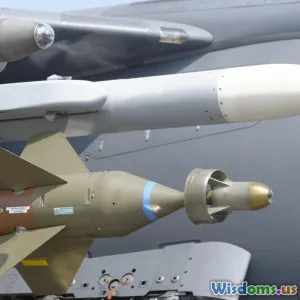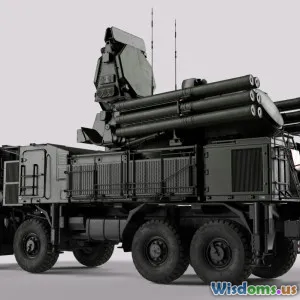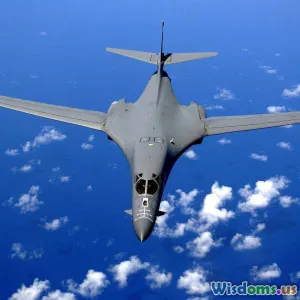
What Helicopter Rocket Launchers Do That Surprises Experts
12 min read Discover how helicopter rocket launchers defy expectations with smart tactics, adaptive munitions, digital targeting, and humanitarian uses, transforming modern aerial warfare. (0 Reviews)
What Helicopter Rocket Launchers Do That Surprises Experts
Introduction: Beyond Boom and Awe
Mention “helicopter rocket launchers,” and most imaginations conjure up the gunship-blasting pyrotechnics seen in war movies or news flashes from conflict zones. It seems simple: point, shoot, and obliterate. But hidden beneath their ugly-duckling exterior and thunderous barrages is a story that leaves even military experts raising their eyebrows.
Helicopter-launched rockets, once outshone by smart missiles and precision bombs, have evolved unrecognizably. They now exhibit capabilities and adaptability that were barely imaginable decades ago. With each foray into advanced targeting, precision guidance, and even humanitarian roles, modern rocket pods perform technological magic and tactical tricks that baffle—and sometimes inspire—those who study battlefield innovation for a living. Let’s peel back the titanium skin, peer into their fire-control computers, and discover how helicopter rocket launchers consistently surprise even the best-informed specialists.
Evolution of the Rotary Rocket Launcher: Not Just Relics
From Massive Salvos to Micro-Control
In the Vietnam Era, helicopter rocket launchers like the 2.75-inch (70 mm) Hydra rocket were straightforward brute force: dozens of unguided rockets hurled toward static jungle targets. Their purpose was maximum saturation—with accuracy often a secondary concern.
Fast-forward to today, and the paradigm has shifted dramatically. The modern AH-64 Apache, Russian Ka-52, or Chinese Z-10 all boast rocket systems that can:
- Switch seamlessly between different types of rockets in a single mission.
- Dial in digital firing solutions for single shots, salvos, or ripple fire based on real-time threat data.
- Retarget in mid-air via pilot commands.
- Track and adjust for wind, humidity, or elevation for highly improved accuracy.
These upgrades allow commanders to “tune” firepower and lethality to the mission—a change that even missile-centric analysts didn’t see coming.
Example: The APKWS Success
One surprising leap is the U.S. Advanced Precision Kill Weapon System (APKWS). Initially dismissed by many as ‘old-fashioned’ compared to Hellfire missiles, APKWS took basic unguided rockets and fitted them with laser guidance kits. Results? More than 93% hit probability—on par with high-end missiles but at one fourth the price. A 2023 RAND study concluded, "The cost-per-effect ratio has upturned assumptions about what’s cost-effective in precision strike scenarios."
International Spin: Global Innovation Race
Experts are startled by how helicopter rocket technology is no longer the exclusive domain of the U.S. or Russia. India’s HAL Rudra, Turkey’s T129 ATAK, and South Korea’s LAH (Light Armed Helicopter) all field highly modern, digitally networked rocket pods. Competition accelerates miniaturization, reliability, and versatile payloads—defying earlier predictions of stalling technological growth.
Unpacking the Surprises: What Experts Never Expected
1. Precision It Never Had—the Smart Rocket Revolution
For decades, experts viewed unguided rockets as "area weapons"—only useful if you wanted a lot of explosive in the vague vicinity of a target. But by integrating laser guidance, GPS/INS units, and programmable fuses, recent rocket pods deliver near-missile performance.
How They Do It
- Guidance Kits: Snap-on technology like the APKWS or Russia’s Ugroza kit allows crews to quickly transform dumb rockets into smart-munitions in the field.
- On-the-Fly Programming: Pilots select proximity, airburst, delay, or impact settings, adapting mid-flight to respond to emerging threats.
Real-World Impact
- In Afghanistan, U.S. Army helicopters using APKWS pods were able to destroy insurgent vehicles hiding under overpasses—a feat that would have needed expensive Hellfires or relentless shelling in the past.
- “We went in expecting to use missiles for bunker-fighting jobs. Instead, APKWS rockets gave us the accuracy without fearing wasted munitions,” remarked Chief Warrant Officer Mark Davis, US Army (2022 interview with Defense One).
2. Tactics Outpacing Tech: Dispersion, Envelopments, and the Art of the Rocket
Rocket pods offer a toolkit for creative tactics:
- Ripple-Fire Patterns: Instead of concentrating fire on a single point, helicopters can saturate a stretch of terrain in a programmed series, denying cover, obscuring movement, or suppressing anti-aircraft teams.
- Micro-Salvo Effects: Firing select rockets with different fuse profiles can force adversaries out of hiding or channel movement into kill zones.
Case Study: Israel’s Lebanon Incursions
Israeli Air Force Apaches in 2006 successfully used bursts of guided and unguided rockets to suppress concealed anti-tank teams hiding in urban terrain—a technique that hadn't been noted in NATO hands and challenged the "missile or nothing" notion.
3. Adaptability to New Munitions—Far Beyond Just Explosives
While classic high-explosive warheads endure, a suite of innovative rockets consistently stuns analysts:
- Multi-Purpose Warheads: Modern rockets swap between anti-armor, anti-personnel, thermobaric, or even smoke and flashbang payloads.
- Non-lethal Adaptations: Turkish defense companies introduced pods capable of firing illumination, white phosphorus, or airburst fragmentation for use in crowd control or disaster aid.
- Programmable Submunitions: NATO exercises have tested rockets with scatterable anti-drone elements—launching clouds of small darts against UAS swarms.
Surprising Development
A 2022 modular pod by Rafael unveiled the ability to load non-lethal riot-control munitions side-by-side with HEAT warheads, allowing pilots to change mission profiles during a single sortie—a capability virtually no observer anticipated a decade ago.
4. Striking From Outside Visual Range
Traditionally, rocket-effective range meant low-altitude, in-your-face engagement—a risky game. Prevailing expert opinion dismissed rockets as “short-ranged.” But recent systems leapfrog with targeting integration:
- Data Linked Targeting: Helicopters now receive midcourse updates via drone or ground spotters, cueing rocket pods onto out-of-sight targets.
- Longer-Range Guided Rockets: Russian S-8L and American ER APKWS stretch ranges to 7-12 kilometers—beyond traditional anti-aircraft reach.
Satellite imaging confirms that during the 2022 conflict in Ukraine, Russian helicopters launched S-8L guided rockets from standoff distances outside the engagement envelope of most man-portable missile systems—once assumed impossible for rockets alone.
The Humanitarian Paradox: Science Fiction Turned Reality
Surprisingly, rocket pods are turning up far from battlefields:
Emergency Response & Disaster Relief
Some modern helicopters, using specially adapted rocket pods, participate in wildland firefighting and disaster response, launching water-mist canisters or chemical agents to break up fuel ether spills.
Notable Example
In 2021, Chinese Z-10 helicopters were filmed using rocket pods to launch seed dispersal capsules in post-fire reforestation missions—delivering life, not destruction, from the sky.
Counter-Drone Revolution
The rise of small, nimble drones threatened to blind anti-aircraft defenses. Yet, helicopters equipped with special airburst rockets or scatter munitions can disrupt drone swarms—in essence, lobbing anti-drone 'flak' barrages as a flying guardian.
Challenging the Critics: Data & Defense Economics
Cost-Benefit Re-Examined
Until recently, the defense establishment assumed only high-end, million-dollar missiles justified fleet investments. But with guided rocket kits available for under $30,000 per shot, militaries rediscover value in massed, modular firepower. RAND finds, “For lightly protected or mobile targets, investment returns in semi-guided rocket systems outstrip legacy or emerging missile categories—especially in low-intensity or urban conflict zones.”
- 2017–2022 US Forces Data: Over 8,000 APKWS rounds expended at a 92% success rate, versus 2,400 Hellfire missiles at triple the price per launch—prompting surprise reassessment in Pentagon budget circles.
Logistics and Fieldability
Rocket pods are lightweight, rapidly reloadable, and often require less logistical support than missile batteries—a clear operational advantage during protracted conflicts or rapid response situations. Logistics officers cite “tenfold improvement in launch-and-leave times on rocket pods versus missile rails.”
The Future: Arsenal for Unknown Wars
As conflicts shift toward contested environments, hybrid warfare, and drone-enabled chaos, helicopter rocket launchers emerge as an unexpected ace. Integrated with AI-driven targeting, miniaturized warheads, and adaptive fire control, their toolkit quickly becomes indispensable in gray-zone competition, urban standoffs, and even disaster relief.
Inspiring Quotes
- “It’s not the weapon that surprises us—it’s the creativity of users who keep reimagining rocket roles,” says Allison Greer, Sr. Analyst at Jane’s Defence (2023).
- “We wrote off the 70mm rocket, and that was a big mistake,” Air Vice-Marshal James Radcliffe (UK) admitted during an International Air Chiefs’ Symposium.
Experts are now focused not on whether rocket launchers will endure—but just how many roles, from precision strike to environmental missions, they’ll continue to rewrite.
Conclusion: Think You Know Rocket Pods? Think Again
What surprises experts most about helicopter rocket launchers isn’t brute firepower—it’s transformation. They blend digital intelligence, precision, modularity, and even humanitarian ingenuity. Their evolution represents a case study in innovation born not from new domains, but from reimagining classic systems. As technology and tactics leap ahead, the only reliable prediction is that rocket pods will keep defying conventional wisdom again and again—reminding us that even simple weapons, in the right hands, can change the face of conflict and peace alike.
Rate the Post
User Reviews
Popular Posts















